Download Pdf [2,32 MB] - MTU Aero Engines
Download Pdf [2,32 MB] - MTU Aero Engines
Download Pdf [2,32 MB] - MTU Aero Engines
You also want an ePaper? Increase the reach of your titles
YUMPU automatically turns print PDFs into web optimized ePapers that Google loves.
Customers + Partners<br />
Not just a mere envelope for the engine: nacelles, like the CF6’s here seen, significantly reduce noise and fuel consumption.<br />
In the development effort, cooperation between<br />
engine maker and nacelle manufacturer<br />
sets in early. “The nacelle people are in<br />
on the game from the outset, to define interfaces<br />
and mountings,” explains Wolfgang<br />
Gärtner, GP7000 program director at <strong>MTU</strong><br />
<strong>Aero</strong> <strong>Engines</strong>. Many of the auxiliary systems<br />
like fire extinguisher, pumps and electrical<br />
adapters need accommodating in a maximally<br />
space- and weight-saving manner. The many<br />
interfaces make the nacelle a rather complex<br />
piece of equipment. “The tricky thing is to<br />
define the interfaces and neatly separate<br />
roles and responsibilities.” Depending on the<br />
program, either the airframer or the engine<br />
builder is responsible for doing the integration<br />
work and compiling the specifications to<br />
be met. “An engine fairing must be a perfect<br />
fit for engine and airframe, and that makes<br />
communication with the airframe manufacturer<br />
mandatory for us,” confirms Peter<br />
Inman, manager business development at<br />
Goodrich <strong>Aero</strong>structures, which provides the<br />
nacelles for the IAE V2500 and other<br />
engines.<br />
For the GP7200 engine fairings, the engineers<br />
have gone the extra mile. For a first<br />
time in their practice, they have made thrust<br />
reverser actuation electrical, as they have<br />
the opening mechanism of the fan fairing.<br />
The heavy fairing opens electrically at the<br />
push of a button, no longer hydraulically as in<br />
earlier programs. When you are facing the<br />
finished product, a weight around two tons<br />
seems little considering the tremendous<br />
size, what with an overall length of 8.50<br />
meters. You could comfortably put an Airbus<br />
A<strong>32</strong>0 fuselage into the four-meter diameter<br />
nacelle.<br />
Apart from the enormous size difference, the<br />
engine fairing is configured much like those<br />
for the smaller PW6000 or other engines. For<br />
turboprop engines, however, there are some<br />
significant dissimilarities: unlike a turbofan,<br />
a turboprop has no thrust reverser mechanism.<br />
“Also, with propeller engines, the air<br />
issuing from the intake below the propeller<br />
hub—that’s what we call the chin intake—first<br />
needs deflecting into the annular engine<br />
The PW6000’s swing-up fairing provides optimum<br />
access for maintenance.<br />
inlet,” explains Dr. Wolfgang Gärtner, who<br />
supervises TP400-D6 development at <strong>MTU</strong>.<br />
“Apart from that, there’re hardly any differences<br />
between fairings for commercial and<br />
comparable military applications.”<br />
When the design engineers worked on the<br />
envelope for the GP7200, they pursued<br />
some new avenues. In the lip of the air<br />
intake, for instance, hot air from the engine<br />
is swirled in cyclone fashion. The air intake<br />
itself, much as on other nacelles, is lined<br />
with composite elements to dampen the<br />
noise. Visible joints have here been eliminated,<br />
however. The upper layer has ports routing<br />
the noise into the honeycomb core and<br />
so damping rather than reflecting it. A further<br />
perforated layer in the interior still<br />
enhances that action. The thrust reverser<br />
system, too, is noise-optimized through the<br />
incorporation of 75,000 holes. Fitting the<br />
engine with this envelope, also called podding,<br />
takes about twelve days. First, in the<br />
engine build-up (EBU) phase, specialists<br />
install some 30 subcomponents, such as piping<br />
and flanges. On the GP7200, the work is<br />
performed by Goodrich. That done, the unit<br />
goes to Aircelle, where it is fitted with the<br />
intake lining, the mounting bracket and the<br />
exhaust nozzle. On a special frame, the workers<br />
then install the composite fan cowl and<br />
the thrust reverser, checking them for perfect<br />
fit.<br />
While the novel nacelles are still in their<br />
infancy, design engineers on either side of<br />
the Atlantic are already working on future<br />
technologies, mostly for noise damping.<br />
Sawtooth-shaped rear nacelle edges might<br />
help create further savings. These chevrons,<br />
as they are called, optimize the mixing of the<br />
fast air stream issuing from the engine with<br />
the ambient air to reduce the noise heard on<br />
the ground and by passengers in the aircraft.<br />
That type of air swirling, however, at times<br />
boosts fuel consumption, because engine<br />
efficiency drops a little. To minimize that<br />
phenomenon, chevrons made from a shapememory<br />
alloy may be used. As a result of the<br />
high temperatures, they will at takeoff bend<br />
downward into the exhaust gas stream to<br />
lower the noise. During cruise, they will cool<br />
and retract into their original position to<br />
again reduce fuel consumption. It’s still too<br />
early in the game to use these chevrons in<br />
actual applications. But chevrons or no,<br />
today’s engine nacelles incorporate more<br />
high-tech content than first meets the eye.<br />
For additional information, contact<br />
Wolfgang Gärtner<br />
+49 89 1489-2803<br />
For interesting multimedia services<br />
associated with this article, go to:<br />
http://www.mtu.de/107Nacelles<br />
18 REPORT REPORT 19


![Download Pdf [2,32 MB] - MTU Aero Engines](https://img.yumpu.com/11154939/10/500x640/download-pdf-232-mb-mtu-aero-engines.jpg)


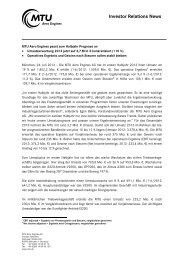
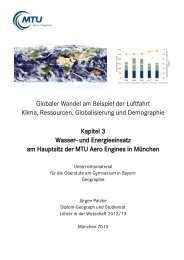
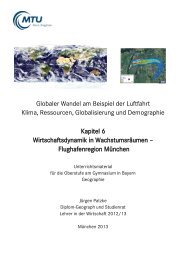
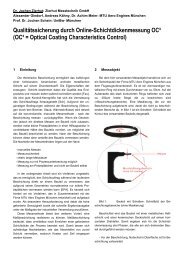
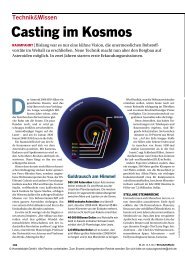

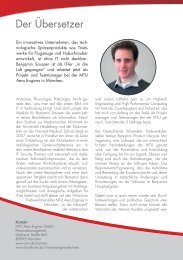
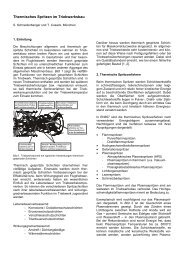
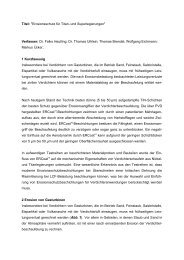



![Download PDF [5,37 MB] - MTU Aero Engines](https://img.yumpu.com/21945461/1/190x125/download-pdf-537-mb-mtu-aero-engines.jpg?quality=85)